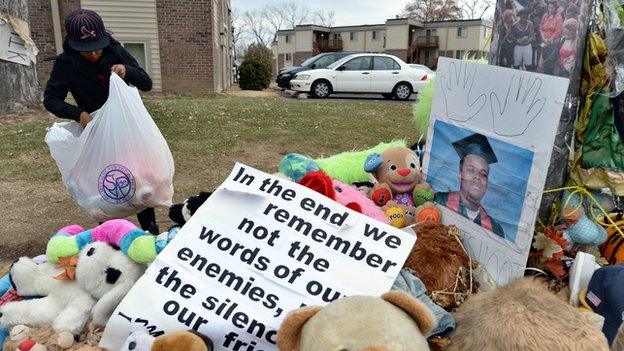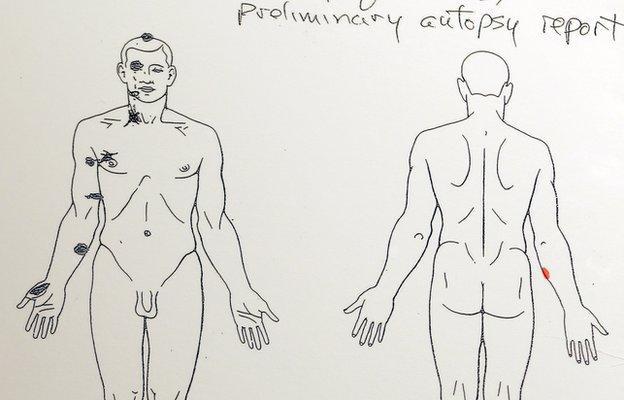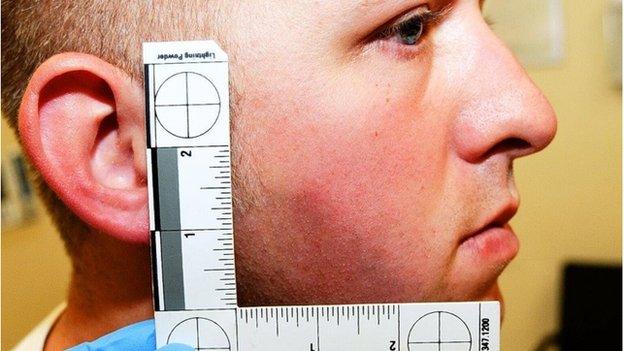Ferguson decision: Official account of final 90 seconds
- Published

A makeshift memorial now sits near where Mr Brown was shot dead
A grand jury in Missouri has declined to indict police officer Darren Wilson in the shooting of unarmed teenager Michael Brown.
St Louis County's top prosecutor Bob McCulloch said the 12-strong panel, made up of nine white and three black jurors, had met on 25 separate days, hearing more than 70 hours of testimony.
State prosecutor Bob McCulloch: No "probable cause" for indictment
He stressed that members of the jury were "the only people who heard every witness... and every piece of evidence.''
At the same time, he suggested that not all of the witness testimony was credible, and that forensics and physical evidence were the best measures of truth.
This is a summary of those facts as stated by Mr McCulloch.
First encounter
According to Mr McCulloch, Mr Wilson first approached Mr Brown and a friend for walking in the middle of the road - but soon saw that Mr Brown matched the description of a suspect in a recent robbery, and was carrying cigarillos, which had been stolen.

CCTV shows a robbery taking place minutes before the shooting. Police say Michael Brown was a suspect
Mr Wilson radioed for backup. Using his police cruiser, he blocked Mr Brown and his friend's path.
With Mr Wilson still seated in the car and Mr Brown standing outside, "an altercation took place", said Mr McCulloch. He said that witnesses described the altercation as "tussling, wrestling, tug of war or just some movement".
Mr Wilson fired two shots; Mr Brown's thumb was grazed. A medical examination later showed that Mr Wilson's face had some swelling and redness.
Bleeding, Mr Brown ran east, chased by Mr Wilson. As Mr Brown turned back and moved towards Mr Wilson, the officer fired several more shots, including the fatal one.

Hands up?
Mr McCulloch offered no definitive statement as to whether Mr Brown had had his hands up. Instead, he relayed several different witness accounts.
"Some described his hands as out to his sides, some in front of him with his palms up, others said his hands were raised near his head, or were by his shoulders, still others said they were by his chest or down by his stomach," said Mr McCulloch. "Others described his hands as in a running position or in fists."
Several witnesses, he said, testified that Mr Brown had never raised his hands, while others said he had.
Gunshots and wounds

A preliminary autopsy report shows bullet wounds on Michael Brown's body
Mr Brown's body fell 135ft (41 metres) from Mr Wilson's car. His blood was located 25ft past that.
In total, Mr Wilson fired 12 rounds. Mr Brown suffered seven or eight gunshot wounds, including the grazed thumb. One may have been a re-entry wound.
He was grazed in the right bicep and hit in the forearm, upper front right arm, lateral right chest, upper right chest, and forehead.
The last shot was to the top of the head. Several wounds indicate that Mr Brown was bent forward at the waist.
Backup arrived 90 seconds after the police officer had first called for it.

The prosecutors released this photo of injuries sustained by Officer Wilson